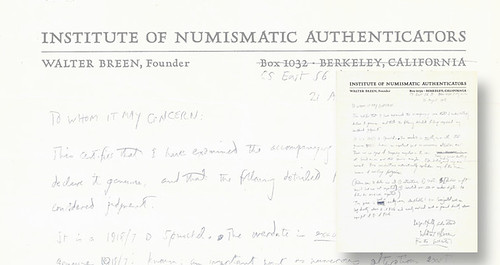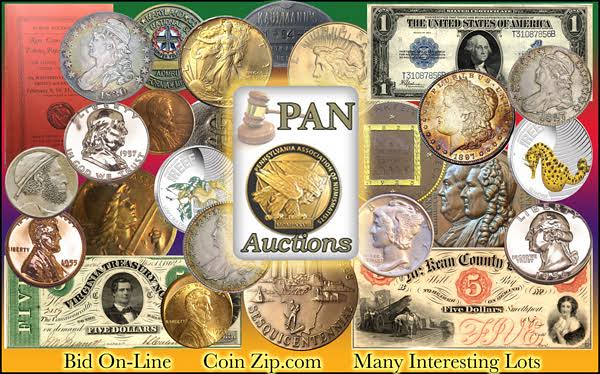
PREV ARTICLE
NEXT ARTICLE
FULL ISSUE
PREV FULL ISSUE
THE INSTITUTE OF NUMISMATIC AUTHENTICATORS
Numismatic ephemera is one of my collecting specialties. In his April 13, 2016 Coin World Numismatic Bookie column, Joel Orosz
discusses a rare letter on stationary of the Institute of Numismatic Authenticators. -Editor

If you landed a time machine in 1961, you'd find yourself in an exciting but troubled time for coin collectors. The hobby was growing, people bought coins by the roll, and values zoomed like helium balloons. But villains lurked in every bourse and coin shop: counterfeit coins, along with their genuine but overgraded evil cousins. The numismatic marketplace was hot, but fakes and misdescribed coins made it a hot mess. Hobby leaders found that educational programs alone could not cleanse the numismatic stable. Finally, some decided to divert a river through it, in the form of a third-party service to determine authenticity (and eventually, grade). The second such service, American Numismatic Association Certification Service, was founded in 1972, and the third, International Numismatic Society Authentication Bureau, was established in 1976. Thirty years ago, the first modern grading service, which certified authenticity, determined grade, and “slabbed” coins, Professional Coin Grading Service, opened its doors. PCGS and ANACS are still industry leaders, but the very first such service is forgotten today. The Institute of Numismatic Authenticators or INA was founded in 1962 by that era's ultimate numismatic scholar, Walter H. Breen. He recruited Don Taxay, a rising star coin dealer, and Lynn Glaser, a numismatic prodigy. One of these three hotshots would examine a coin, then issue a handwritten certificate of genuineness on INA letterhead, explaining the reasons for their determination. It was numismatic brainiacs against the counterfeiters, but the heroes immediately encountered problems. INA neither encapsulated nor photographed the coins they examined, so it was easy for crooks to submit a genuine coin in order to get an INA certificate, then switch out the genuine piece for a bogus one. But the biggest reason INA quickly folded was sloppy “safeguards.” As fellow Coin World columnist David Alexander has written, INA's “office” was Breen's fourth-floor walk-up New York apartment, and the absent-minded Breen lost several valuable coins in his own clutter, including an 1804 Draped Bust gold eagle eventually found, after a frantic search, languishing under a sink! INA went belly-up in 1963, but Breen retained the letterhead, and used it for years thereafter, as demonstrated by the illustrated certificate from Aug. 21, 1968. Breen, bewhiskered and resplendent in his tie-dyed shirts, shorts and sandals, was regularly approached on the bourse for on-the-spot coin authentication. Ironically, someone began forging Breen's certificates, and he responded by writing with a highly distinctive violet ink. This “pre-violet” 1968 certificate focused on a 1918/7-D Indian Head 5-cent coin, which Breen "unhesitatingly" declared genuine because: the overdate is identical to all known originals; the coin shows no signs of tampering; it has all of the required diagnostics. He even graded it as “Good +.” The coin was long ago separated from the certificate and probably resides in a modern slab. To read the complete article, see:

Wayne Homren, Editor The Numismatic Bibliomania Society is a non-profit organization promoting numismatic literature. See our web site at coinbooks.org. To submit items for publication in The E-Sylum, write to the Editor at this address: whomren@gmail.com To subscribe go to: https://my.binhost.com/lists/listinfo/esylum All Rights Reserved. NBS Home Page Contact the NBS webmaster 
|